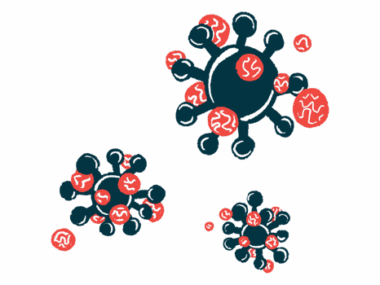Uplizna found effective in Asian NMOSD patients in Phase 2/3 trial
Safety, efficacy of approved therapy is similar to other patients in trial
Written by |

Treatment with Uplizna (inebilizumab-cdon) effectively prevented disease attacks and disability worsening for Asian people with neuromyelitis optica spectrum disorder (NMOSD) in the Phase 2/3 N-MOmentum clinical trial, a new analysis found.
“In the Asian [patient] subgroup, the risk of NMOSD attacks was reduced with [Uplizna] versus placebo … and the attack-free rate at 28 weeks [nearly seven months] was 82.1% with [Uplizna] versus 37.5% with placebo,” the researchers wrote.
The results of the subgroup analysis show that the safety and efficacy of Uplizna among Asian participants in N-MOmentum were comparable to the findings in non-Asian patients.
“The incidence of treatment-emergent adverse events [side effects] was similar between the Asian and non-Asian subgroups,” the team wrote.
The study, “Efficacy and safety of inebilizumab in Asian participants with neuromyelitis optica spectrum disorder: Subgroup analyses of the N-MOmentum study,” was published in Multiple Sclerosis and Related Disorders.
Team analyzes N-MOmentum trial results with focus on Asian patients
Uplizna is a medication designed to target B-cells, a type of immune cell with a central role in driving NMOSD. It is widely approved as a treatment for the disorder — including in China, where it’s marketed by Hansoh Pharmaceutical Group, and in Japan, where it’s sold by Mitsubishi Tanabe Pharma Corporation.
Approvals of the therapy were based mainly on data from the N-MOmentum clinical trial (NCT02200770), an overall 5.5-year study that tested Uplizna against a placebo in people with NMOSD. The trial was run by MedImmune, acquired by AstraZeneca, and Viela Bio, now part of Horizon Therapeutics, which sells Uplizna in the U.S. and Europe.
While the study had positive results, “the efficacy and safety outcomes of [Uplizna] specific to an Asian population were not fully reported,” the researchers noted.
Now, a team of scientists evaluated the effects of Uplizna among the subset of participants in N-MOmentum who identified as Asian. A similar analysis recently had been performed examining the therapy’s effects among participants in Europe.
“NMOSD prevalence varies by race, and race also influences the severity of NMOSD and clinical outcomes. Therefore, it is possible that the therapeutic response to treatment with [Uplizna] could differ between Asian and non-Asian individuals,” the researchers wrote.
Of the 230 participants in N-MOmentum, 47 were Asian. Among both Asian and non-Asian patients, most participants were female, the mean age was in the early 40s, and most patients were positive for AQP4-IgG, a type of antibody that usually drives NMOSD.
Prior to the trial’s start, clinical factors were generally comparable for Asian and non-Asian patients, though Asian patients tended to have longer disease duration and lower rates of relapses. Such relapses are defined as attacks in which NMOSD symptoms suddenly worsen.
Lower rates of disability worsening, relapses seen with Uplizna
The results showed that, over the first six months of the N-MOmentum trial, the rate of relapses was about 80% lower among Asian patients given Uplizna, compared with those who received the placebo. During that time, more than 4 of every 5 Asian patients on Uplizna were relapse-free, compared with less than half of those on the placebo.
Rates of worsening disability, new disease activity on MRI scans, and hospitalizations also tended to be lower for Asian patients on Uplizna compared with the placebo. Measures of eyesight were generally similar between the two groups.
After the first six months of N-MOmentum, patients who had originally been on placebo were switched to Uplizna, and all were followed for an average of more than three years.
Over long-term Uplizna treatment, the average rate of NMOSD relapses was less than 0.1 per year among Asian patients positive for AQP4-IgG — a dramatic reduction compared with before the trial, when these patients averaged slightly more than one attack per year.
Collectively, the efficacy data in Asian patients were similar to what was seen for non-Asian patients.
The magnitudes of these therapeutic effects were similar to those in the non-Asian and overall population, suggesting that [Uplizna] was equally effective in the Asian subgroup.
“This subgroup analysis of N-MOmentum demonstrated the superiority of [Uplizna] over placebo in reducing the risk of an NMOSD attack, progression of disability, MRI lesion activity, and disease-related hospitalizations in Asian participants,” the researchers wrote.
“Furthermore, the magnitudes of these therapeutic effects were similar to those in the non-Asian and overall population, suggesting that [Uplizna] was equally effective in the Asian subgroup,” the scientists concluded.
Safety data also were comparable between Asian and non-Asian patients, with common side effects found to include respiratory infections or the common cold, back pain, and joint pain.
The researchers noted that joint pain was reported somewhat more often among Asian compared with non-Asian patients, whereas urinary tract infections (UTIs) were markedly less common among Asian patients.
These differences might be due to small variances in clinical factors prior to treatment, according to the scientists. For example, Asian patients generally had better mobility, and being mobile is known to help reduce the risk of UTI.
But the team said further work may be needed to fully understand the reasons for these differences, and in the meantime, noted it may be useful for clinicians to carefully assess for joint pain in Asian patients.







